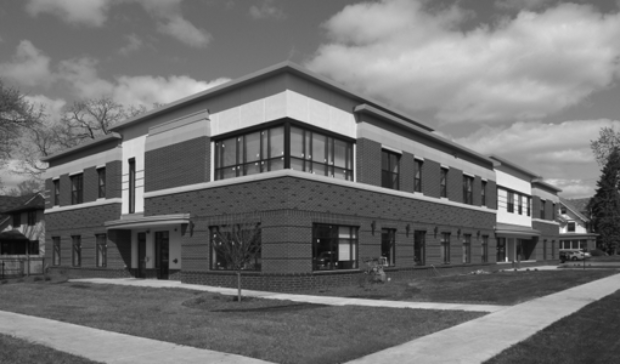When I pick up my 2-year-old daughter, Emily, from St. Thomas' child DevelopmentCenter, she runs to me with a huge grin and a sparkle in her eyes. She usually smells of sun screen and probably has Play-Doh stuck in her shoe treads. Chances are excellent that Mickey Mouse is stamped on her knee and a few crumbs of a snack linger in the corners of her mouth. She’s messy and sticky, but all I feel is relief – my daughter is happy and having a good time.
My wife and I knew that child care would play a part in our child’s life, and we wanted that part to be positive – both for her and for us. Childhood should be a time to use crayons and spill food and make friends. Childhood for parents should mean that your child is safe, enjoying herself and learning some developmental basics – and we wanted to find a day care which would give that to Emily.
In May 2004, when Emily was 1 year old, we got the call that there was a space open at the center. It came as such a relief – Emily would be close to my office, we had heard only good things about the center, and there was talk of a new building. A win-win situation!
If you build it …
The Child] DevelopmentCenter at St. Thomas came into being in 1998, with the support of Greg Roberts, then vice president of student affairs. According to Becca Swiler, director of the center, Roberts considered that a child care center would add value to the students, faculty and neighborhood of St. Thomas.
With the support of the university’s administration, a committee of students, faculty, alumni and friends created a business plan for the center and Swiler was hired as director. She had the daunting task of hiring staff, establishing the space in Christ Child Hall, finding applicants and getting the center licensed within six months. She did it all and the center opened in September 1998 with a waiting list of 135 children, which surprised everyone.
For seven years, the center was located in the Christ Child space. The space was awkward and cramped, and in the past few years started showing its age. Then came the announcement in 2003 that the center would relocate to a new building on the corner of Finn Street and Grand Avenue. “That was a very happy day,” recalled Swiler. “I remember thinking: wonderful, let’s get to work on the design!”
Again, she had to start to build a center, literally from the ground up. “Probably the biggest challenge was keeping the current program operating at full capacity and top quality while trying to plan the new building and program,” Swiler said. “In many ways it was like having two full-time jobs – for me and for all the professional staff.”
The new building, which opened April 13, took several months to plan and was built by Minneapolis-based Ryan Companies. The lower level and first floor belong to the center and the second floor is a residence reserved mainly for student workers at the center.
Concessions to licensure requirements, budget and lot space were made, but the final result is a perfect metaphor of the St. Thomas community, believes Jane Canney, the current vice president of student affairs. It houses and employs students and offers services to student, faculty, staff and neighborhood parents. “The new building was truly an institutional effort,” said Canney. “People were involved at every level, from the administration who supported the vision for the center, to parents who helped to move the center from Christ Child, to the facilities staff who hand-built the custom cabinets.”
Inside the center …
When Swiler established the center, her goal was to create a place that would speak to the university’s mission, while focusing on providing quality programming for the children. “It isn’t babysitting, and it isn’t women’s work,” Swiler said. “We have a very small window of time to create a strong developmental focus in kids and that is our goal.” To that end, Swiler chose the Creative Curriculum as the educational basis for the center.
This curriculum provides children with the basic building blocks to achieve development in all areas. Kids learn how to think, how to observe and how to interact – skills that will serve them well once they start learning in an academic setting. As the center’s Web site states:
We know that children learn by doing, and they must have the space and time to explore and discover independently, to take reasonable risks and to challenge their minds and their bodies. Infants focus on developing secure attachments to adults, a healthy self image, large and small motor skills and receptive and expressive language skills. Toddlers build on the skills begun in infancy and in addition focus on sensory, large muscle, social and self-help skills. Preschoolers develop skills related to problem solving, abstract thought, language, critical thinking and socialization.
Walk into any of the rooms in the center and you will see evidence of the teachers’ commitment to this curriculum: teachers spending one-on-one time with infants, toddlers “talking” to each other on phones, or a blueprint of the new garden designed and planted by the preschoolers.
The hands that rock the cradles …
As Swiler indicated, day care is more than babysitting. The center’s 11 teachers are knowledgeable about the developmental stages of the 67 children. Teachers attend in-service workshops and accredited courses and regularly renew their first-aid and CPR training. The Child Development is licensed by the Minnesota Department of Human Services, which also sets guidelines for the child care staff.
While that sounds clinical and cold, my wife and I have found the teachers to be warm, friendly and caring. Emily has a sight impairment – she needs to wear glasses all day and a patch for four to six hours a day. The teachers in both her infant and toddler rooms have been extremely considerate and helpful in getting her adjusted to this situation, but also making sure that the other children understand. We continue to be touched by their support and care.
Also in the center are interns from the early childhood, special education and parent education programs. Student teachers and interns from St. Thomas, Bethel, the University of Minnesota, Concordia and St. Kate’s work and train in each of the classrooms. These students are right in the middle of the action and work alongside the teachers, reading a book, putting on a band-aid or changing a diaper. They bring a vitality and excitement to the rooms and form tight bonds with the children.
Canney considers the living and learning environment of the center to be unique: “Having students live above where they work may be the first in the nation.” Also, said Canney, the center offers a fantastic opportunity for collaboration between St. Thomas faculty and students for academic work and research.
This summer, the center hosted another educational opportunity for incoming St. Thomas students. Four members of the Reaching Excellence in Academics and Leadership (REAL) project spent six weeks working in the center. The REAL project involves students of color, immigrants and women, and is designed to acquaint high-school students with campus life.
Lucky to be here …
Outside of St. Thomas, what does day care look like? During my preliminary research for this article, I felt my wife and I had battalions of peers across the state and country who were similarly engaged in the psychological, economical and logistical battle to find a child care opening.
For instance, of the five institutions in the ACTC (Associated Colleges of the Twin Cities), St. Thomas is the only one that offers day care for children from 6 weeks to 5 years old. St. Kate’s offers care to kids from 33 months to 6 years, and offers resources for parents who need additional child care. Hamline closed its day care within the past few years. The University of Minnesota-Twin Cities has a day care – but the wait time is a year to 16 months at minimum. Even at other universities such as MIT, Michigan State or George Washington, the names on the wait lists range from 20 to 350. The waiting list at St. Thomas averages about 375.
Finding quality day care outside the world of academic institutions isn’t much better. In a 2001 report, the Minnesota Child Care Resource and Referral Network (MCCRRN) published these findings on child care in RamseyCounty:
•33 percent of parents found no child care openings based on the ages of their children
•The demand for day care for children ages 0-12 was 57,000; the supply was only 29,000.
In the state of Minnesota, MCCRRN determined that there are roughly 274,221 licensed spaces for the 562,120 children under 12 whose parents are in the work force.
And cost? According to MCCRRN, the average cost for infant care in a center is $6,344 per year or 59 percent of take-home pay at minimum wage. At St. Thomas, fees range from $412 to $1,199 a month depending on the age of the child and schedule. The center does have a payment plan in place for those families who qualify; however, the purpose of the center, as indicated in its mission, is to be of service to the St. Thomas community and not be a profit center.
But with 13 million preschoolers – including 6 million infants and toddlers – who are in child care across the country, and for the millions of parents who make the difficult decision to return to work, the challenge to find and afford day care is one to meet head on.
In fact, Art Rolnick, the director of research and public affairs at the Federal Reserve Bank of Minneapolis, believes this battle is worth fighting. His advocacy for high-quality early child care reflects his research of early childhood studies with an eye toward a return on investment for public funds. His findings indicated that if children get the care and nurturing they need during those important first few years, they enter kindergarten better equipped with the skills for learning. That preparedness results in kids who are less likely to drop out of school, be arrested as juveniles or need welfare benefits as adults, all of which can validate the need for financial support of those seeking daycare.
This morning, when I dropped off Emily at the center, I kept spinning these facts and figures through my head. My ruminations were interrupted by Emily’s squeak of joy as she saw a tub of brightly colored toys and her friend Natalie. Smiling, I said goodbye, waved, and watched as she blew me a kiss before getting down to the business of being a kid. It’s not easy to trust another with the care of your child, but when they are content, it helps.
Peter Breuch is director of marketing communications for St. Thomas.







